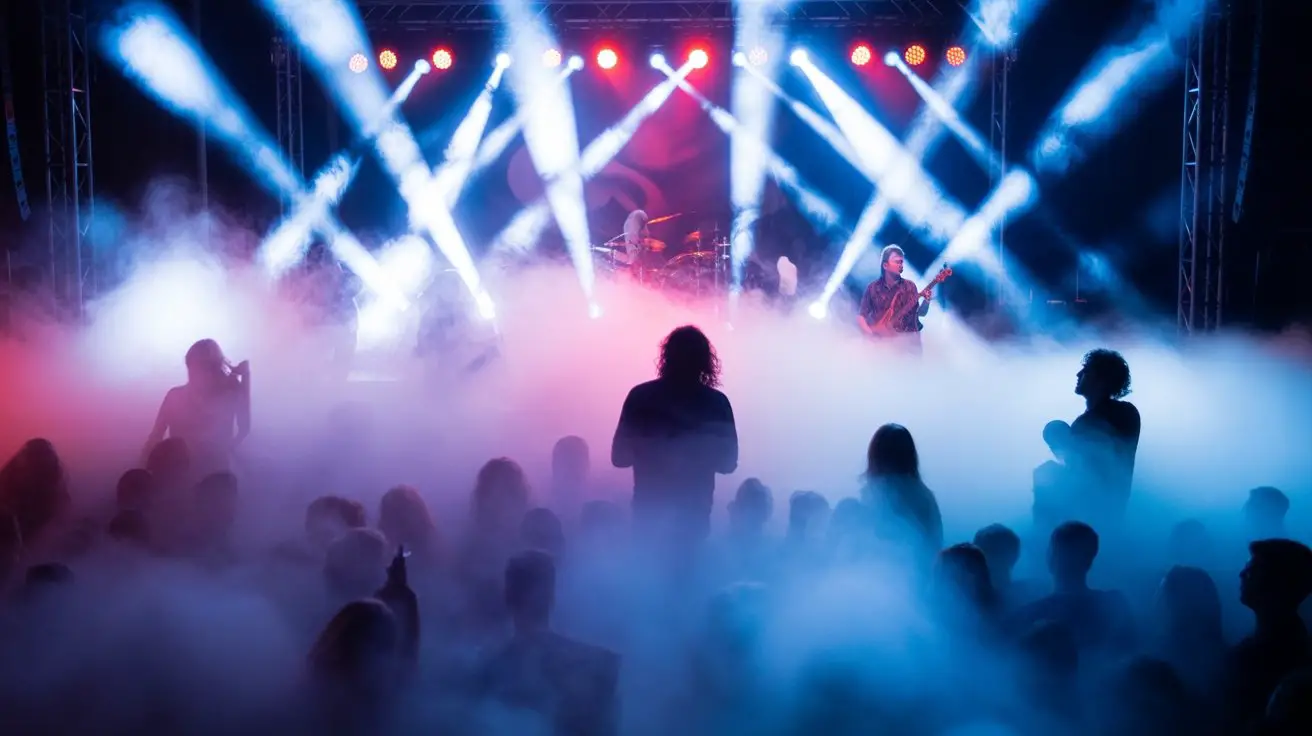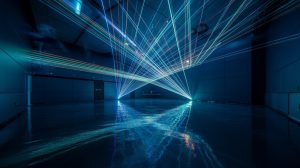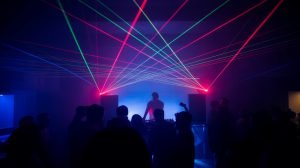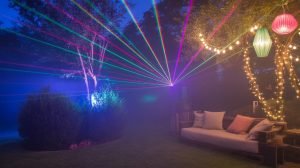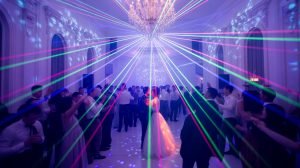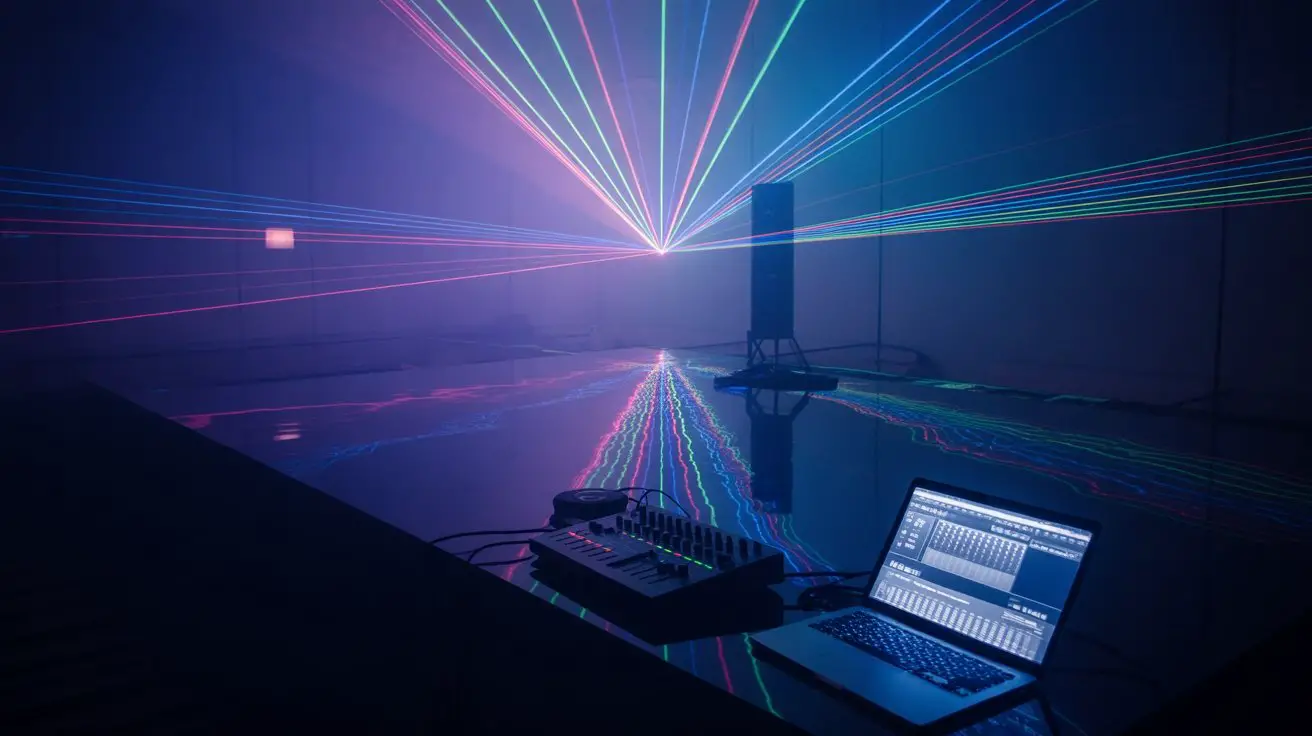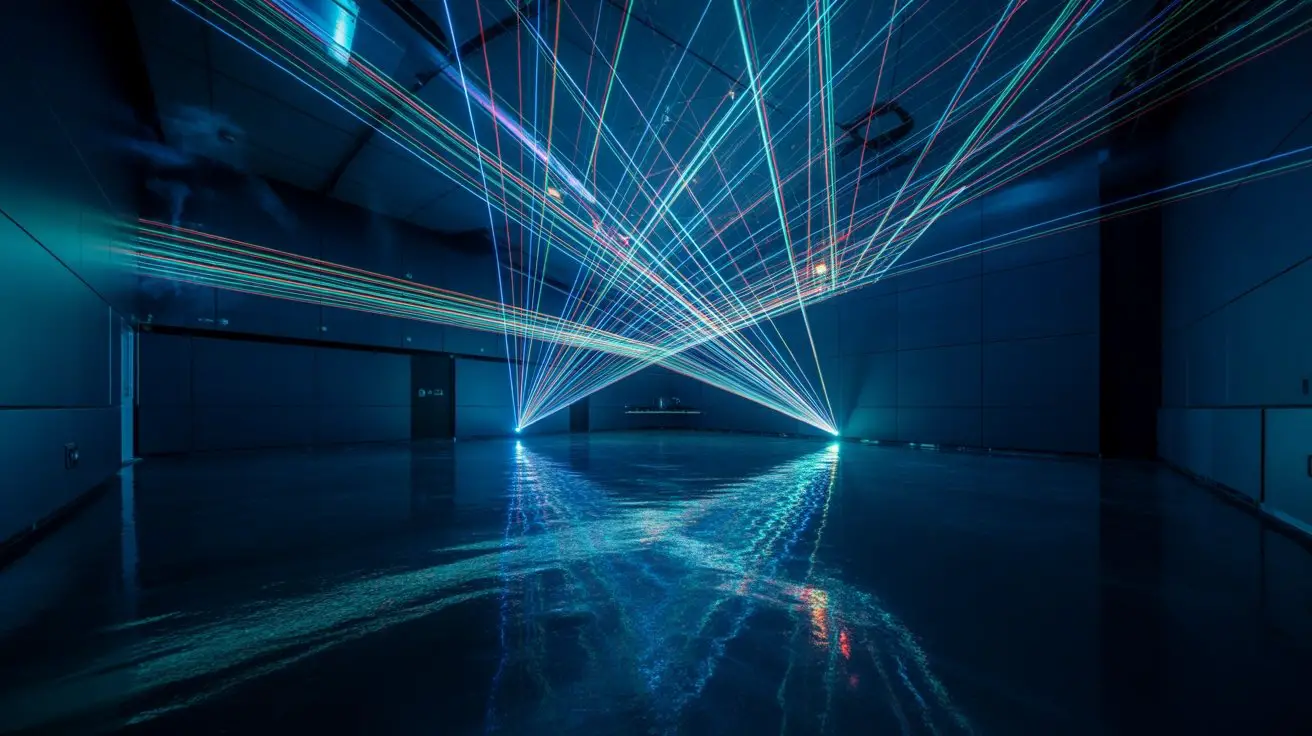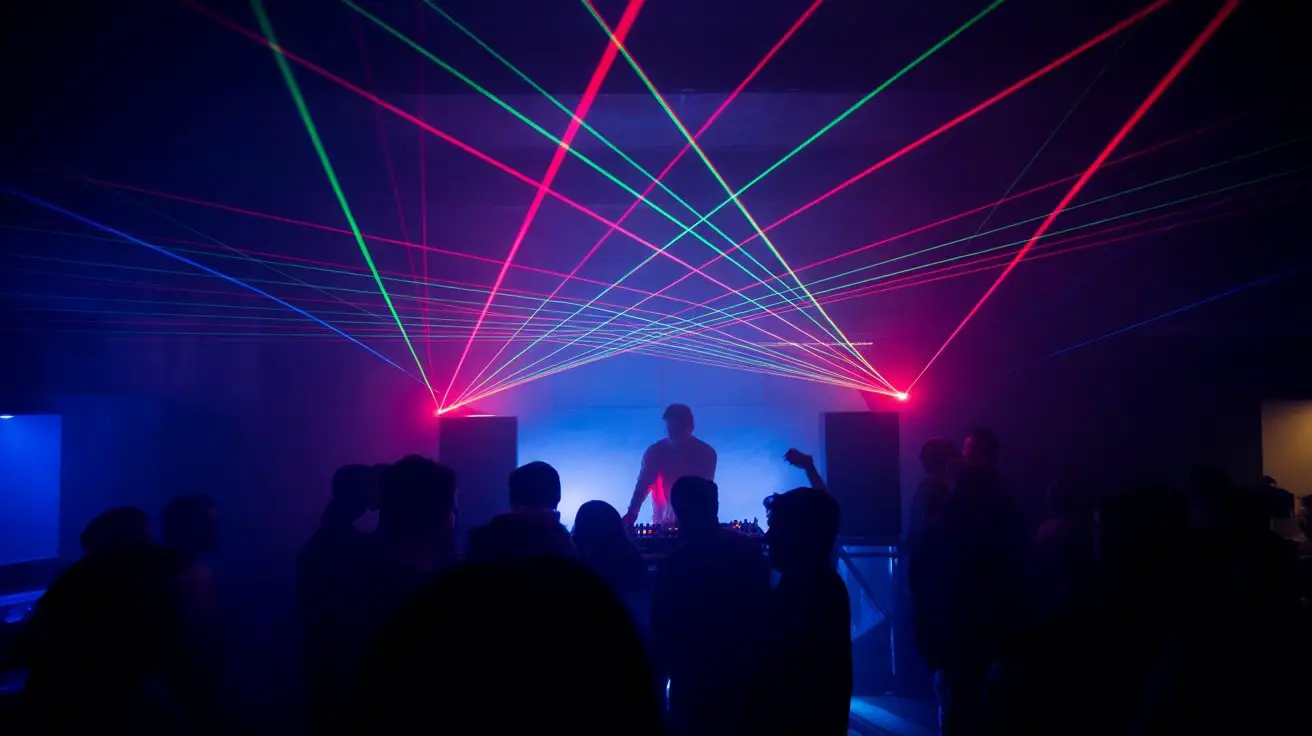Just as a master chef controls steam to reveal a perfectly cooked dish, you’ll need to master fog machine timing and density to disclose your concert’s most dramatic moments. You’re dealing with DMX protocols, fluid viscosity ratings, and HVAC interactions that can make or break your atmospheric effects. One mistimed fog burst during a guitar solo, and you’ve obscured the artist instead of enhancing them. The difference between amateur haze and professional atmosphere lies in understanding the technical fundamentals that separate stunning visuals from costly mistakes.
Types of Fog Machines and Their Applications
When selecting fog machines for concert applications, you’ll encounter three primary categories: thermal foggers, chilled foggers, and haze machines, each engineered for specific atmospheric effects and venue requirements.
Thermal foggers generate dense, low-lying fog using heated fog fluid, creating dramatic ground-level effects ideal for theatrical moments. However, they dissipate quickly and require proper ventilation protocols.
Chilled foggers produce longer-lasting, ground-hugging fog through cooling systems, perfect for sustained atmospheric coverage. They’re suitable for outdoor venues where wind dispersion is prevalent.
Haze machines create fine, translucent particles that enhance lighting beam visibility without obscuring performers. They’re essential for laser shows and architectural lighting displays. Fog machines can also be modified to produce haze effects, allowing for versatility in atmospheric design.
Consider venue size, HVAC systems, and fire safety regulations when selecting equipment.
DMX-compatible units offer precise timing control, while fluid consumption rates affect operational costs and refill frequency during extended performances.
Essential Equipment and Fluid Selection
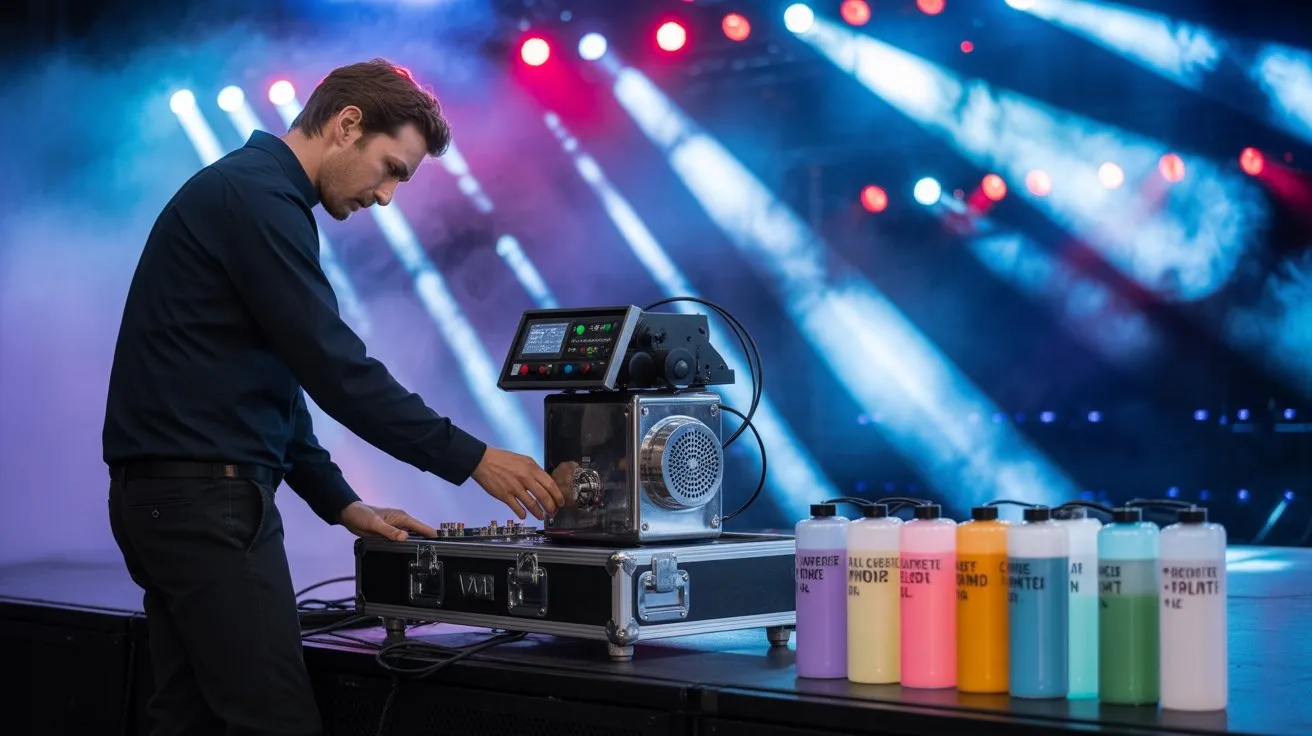
Essential accessories include DMX controllers for synchronized timing, remote triggers for precise cue activation, and distribution fans for directional fog flow. Safety equipment encompasses ventilation fans, fogger cooling systems, and emergency shut-off switches.
Fluid selection directly impacts output quality and venue safety. Water-based fluids produce lighter, faster-dissipating fog suitable for quick atmospheric effects. Oil-based fluids generate denser, longer-lasting fog but require enhanced ventilation. Always verify fluid compatibility with your specific machine model to prevent equipment damage. Consider glycol-free options for venues with sensitive individuals.
Additionally, understanding glycol-based fluids will help you choose the right mixture for your desired fog effect. Never substitute automotive antifreeze or homemade mixtures, as these create toxic fumes and void equipment warranties.
Venue Assessment and Safety Considerations
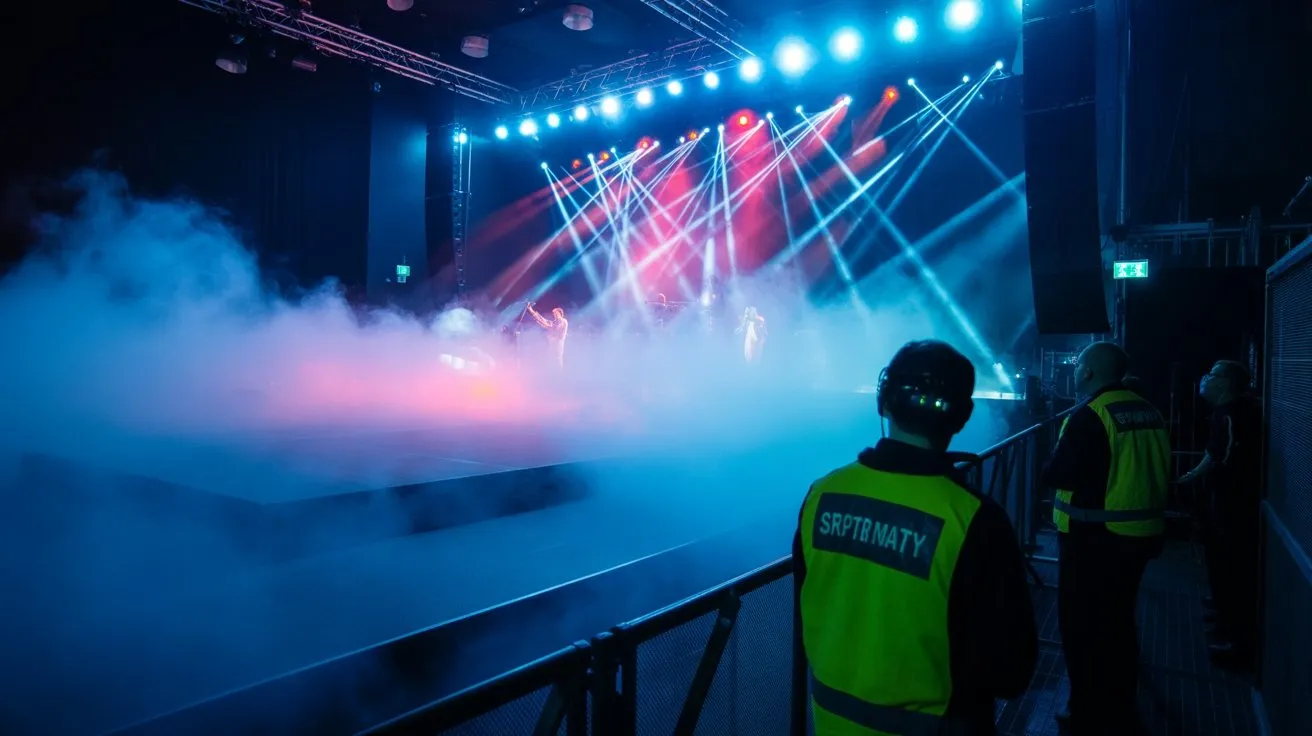
Proper venue evaluation determines your fog machine deployment strategy and safety protocols.
You’ll need to assess ceiling height, ventilation systems, and fire suppression equipment before positioning units. Check local fire codes and obtain necessary permits, as many jurisdictions require advance notification for theatrical fog use.
Identify emergency exits and confirm fog won’t obscure egress paths or safety signage when deployed.
Test venue HVAC systems to understand air circulation patterns that’ll affect fog distribution and dissipation rates. Document any sensitive equipment like smoke detectors that might trigger false alarms.
Establish clear sight lines for lighting operators and security personnel.
You must verify adequate power distribution for your fog machines and create detailed evacuation procedures specific to reduced visibility conditions during performances. Additionally, be aware that prolonged exposure to fog can increase airway resistance in asthmatic individuals.
Timing and Cue Integration With Performance
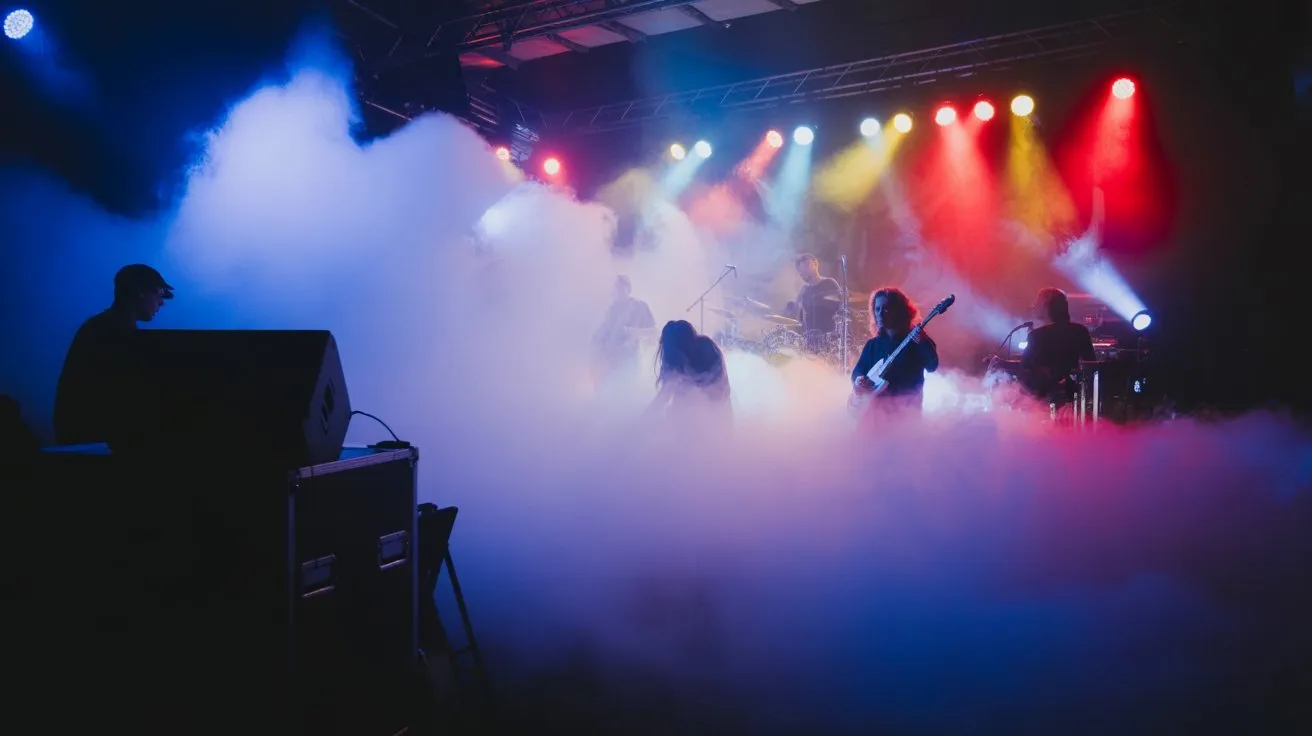
Synchronize fog deployment with musical crescendos, lighting changes, and performer movements to maximize visual impact without compromising stage safety.
You’ll need precise cue sheets coordinating fog timing with your lighting console and audio engineer. Program fog machine triggers into your lighting board’s playback sequences, ensuring consistent activation across performances.
Monitor fog density levels during rehearsals to establish ideal output durations. Brief fog bursts work best for dramatic reveals, while sustained output enhances atmospheric segments.
Coordinate with your stage manager to integrate fog cues into the master show calling script.
Install remote-triggered fog machines to eliminate manual activation delays. Position backup operators with clear sightlines to performers for emergency fog cessation.
Test all cue sequences during technical rehearsals to verify timing accuracy and performer visibility maintenance. Additionally, ensure proper ventilation requirements are met to maintain a safe environment for performers and audience members.
Coordinating Fog Effects With Lighting Systems
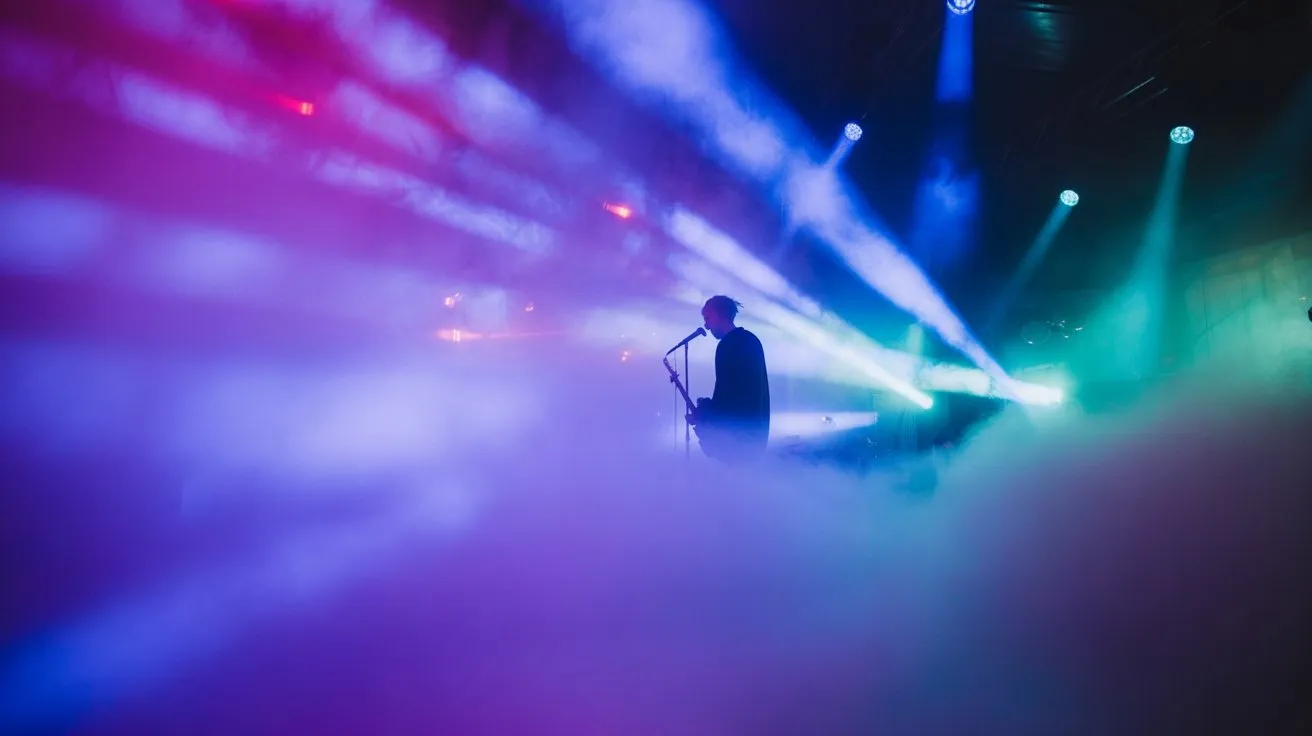
When fog effects interact with your lighting rig, you’ll create dramatically enhanced visual depth and beam definition that transforms ordinary stage illumination into sculptural elements.
Position your fog machines strategically to intercept key light paths—uplights, back lights, and moving head fixtures produce the most dramatic beam visibility.
Configure your lighting console to trigger fog cues automatically, ensuring proper timing between haze deployment and light activation. You’ll need 30-60 seconds lead time for fog to reach ideal density before illumination.
Adjust your fixture intensity levels accordingly, as fog reduces light transmission by 15-30%. Use color temperature contrasts effectively—cool blues and purples create ethereal atmospheres, while warm ambers produce intimate, smoky environments.
Monitor fog density continuously to maintain consistent beam definition throughout your performance. Additionally, be aware that fog machines can trigger fire alarms due to smoke particles, so it’s essential to coordinate with venue staff regarding alarm sensitivities.
Positioning and Coverage Strategies
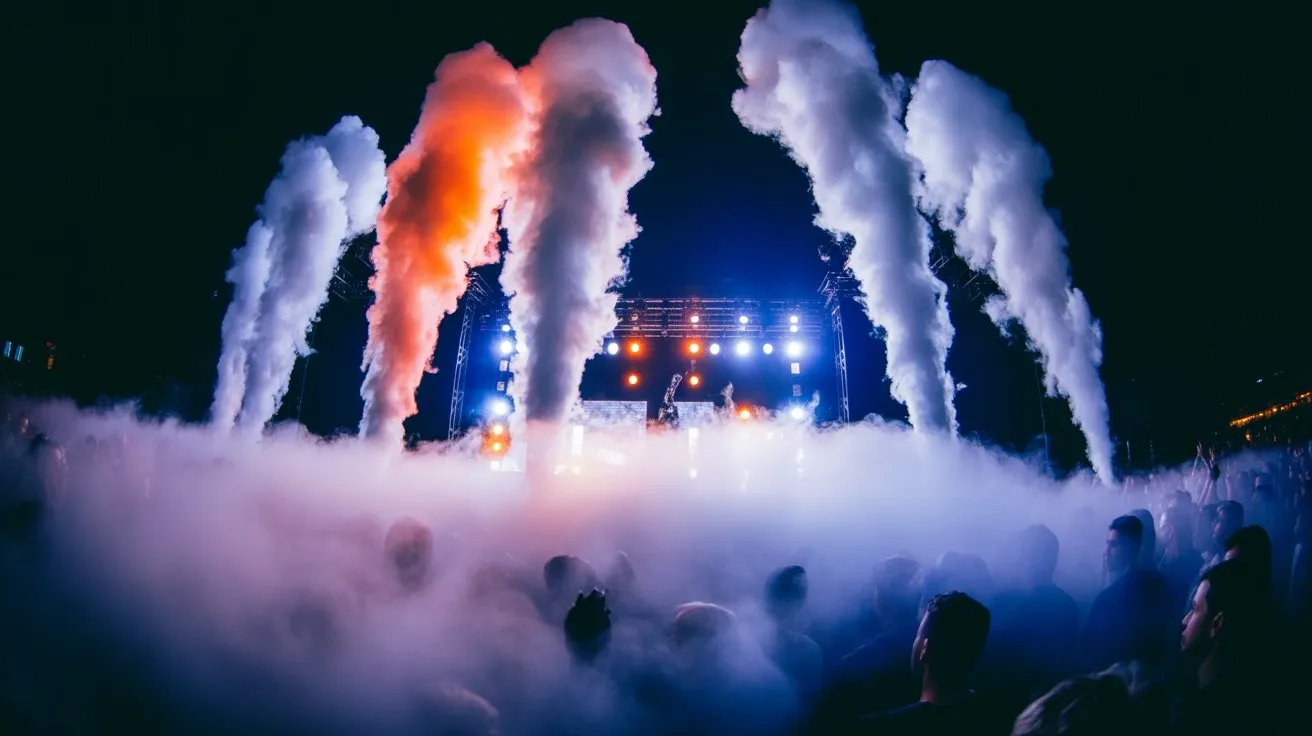
Strategic placement of fog machines determines the effectiveness of your atmospheric coverage and directly impacts audience experience across the venue. Position units at stage front for low-lying effects that enhance performer visibility through selective illumination. Upstage placement creates dramatic backdrops while maintaining clear sightlines.
| Position | Coverage Pattern | Primary Application |
|---|---|---|
| Stage Front | Wide, Low Distribution | Performer Enhancement |
| Upstage | Vertical Wall Effect | Backdrop Creation |
| Side Stage | Directional Sweep | Scene Changes |
Calculate CFM output requirements based on venue cubic footage and air circulation patterns. Install machines at varying heights to create layered atmospheric density. You’ll need one machine per 2,000 square feet for adequate coverage. Consider HVAC system integration to prevent unwanted dissipation and guarantee consistent atmospheric maintenance throughout performance duration.
Managing Fog Density and Dispersion

Although fog density appears straightforward to control, you’ll need to master fluid flow rates, ambient temperature variables, and ventilation patterns to achieve consistent atmospheric effects.
Monitor your machine’s output rate continuously, adjusting fluid injection timing based on HVAC system cycles. Cold air masses sink fog rapidly, while heated venues create thermal updrafts that disperse effects unevenly.
Calculate your venue’s cubic footage and establish baseline dispersion rates during sound check. Position intake fans strategically to prevent dead zones where fog stagnates.
Test viscosity levels at different temperatures—thicker fluids produce denser fog but require higher heat settings. Install atmospheric monitors to track particle density and guarantee breathable air quality.
Coordinate with lighting technicians to prevent excessive haze that obscures beam definition or creates unwanted light scatter.
Troubleshooting Common Technical Issues

Since fog machines operate under high-temperature conditions with pressurized fluid systems, you’ll encounter predictable failure patterns that demand systematic diagnostic approaches.
When output diminishes, check fluid levels first, then inspect heating element functionality using thermal readings. Clogged nozzles require immediate disassembly and cleaning with manufacturer-approved solvents.
Pump failures manifest through irregular fluid delivery or complete cessation. Test pump motor continuity and examine internal seals for degradation.
Temperature sensors failing will trigger safety shutoffs—verify calibration against known standards.
Electrical issues typically stem from damaged control boards or corroded connections. Use multimeters to trace circuit integrity.
Remote control malfunctions often indicate DMX signal interference or addressing conflicts.
Always power down units completely before conducting internal diagnostics.
Maintain detailed service logs documenting repair intervals and component replacements for ideal preventive maintenance scheduling.
Post-Performance Maintenance and Storage
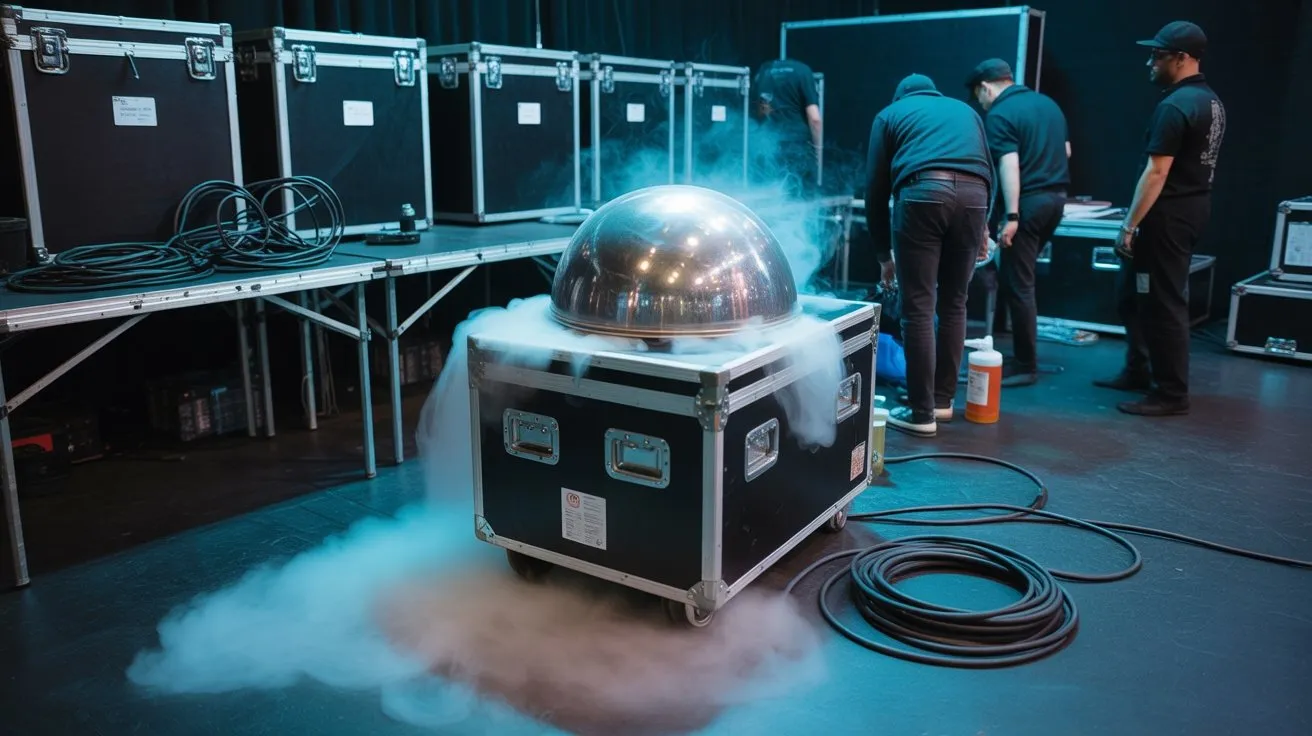
Proper maintenance procedures begin immediately after your final fog output ends, requiring systematic fluid drainage and component inspection while equipment remains warm.
Drain residual fog fluid from the reservoir to prevent mineral buildup and bacterial growth. Flush the heating block with distilled water, then purge completely to avoid freeze damage. Inspect heating elements for carbon deposits and clean with manufacturer-approved solvents. Check DMX connections and power cables for wear or heat damage.
Store machines in temperature-controlled environments between 50-80°F with humidity below 60%. Remove fluid containers and cap all ports. Coil power cables loosely to prevent conductor stress. Document operating hours and maintenance performed.
Schedule periodic deep cleaning based on usage frequency. Proper storage extends equipment lifespan and guarantees consistent fog density for future performances.
Frequently Asked Questions
What Permits or Licenses Are Required to Operate Fog Machines at Concerts?
You’ll need venue fire permits, atmospheric effects licenses, and health department approvals. Check local fire marshal requirements, building codes, and entertainment licensing regulations. Contact authorities early since permit processing times vary considerably.
How Much Does It Typically Cost to Rent Professional Fog Machines?
Need fog effects that won’t break your budget? You’ll pay $50-200 daily for entry-level hazers, while high-output atmospheric generators cost $200-500+ per day, depending on DMX capabilities and fluid consumption rates.
Can Fog Machines Trigger Fire Alarms or Sprinkler Systems During Performances?
You’ll trigger photoelectric smoke detectors with dense fog output, but ionization detectors remain unaffected. Heat-activated sprinklers won’t engage since fog machines don’t generate sufficient thermal signatures. Notify venue fire safety personnel and disable relevant detection zones before deployment.
Are There Health Risks for Performers or Audience Members Exposed to Fog?
Like diesel exhaust affecting highway workers, you’ll face respiratory irritation from glycol-based fog fluids. Prolonged exposure causes throat dryness, coughing, and potential bronchial sensitivity. Guarantee proper ventilation and consider water-based alternatives for vulnerable performers.
What Insurance Considerations Should Be Addressed When Using Fog Machines at Events?
You’ll need extensive liability coverage addressing slip-and-fall incidents, respiratory reactions, and equipment malfunctions. Verify your policy covers atmospheric effects, obtain venue-specific endorsements, and document all safety protocols to satisfy underwriter requirements and minimize claims exposure.
Conclusion
You’ve mastered the fog machine’s arsenal—from selecting the right equipment to orchestrating seamless integration with your lighting rig. Like a conductor wielding precision timing, you’ll synchronize atmospheric effects that transform performances into breathtaking spectacles. Remember, safety protocols aren’t optional; they’re your lifeline in live production. With proper venue assessment, density management, and regular maintenance cycles, you’ll consistently deliver those show-stopping moments that leave audiences mesmerized while maintaining industry-standard operational integrity throughout every performance.

